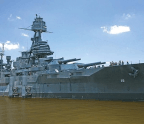

The first tentative steps towards a fully-fledged naval air force occurred in the waters off Hampton Roads in Virginia when Eugene Ely bravely launched himself off the bows of the cruiser USS Birmingham. The biplane rolled off the gently sloping temporary structure built over the cruisers’ bows on November 14th, 1910. It was to be on the other side of the continent and two months later in San Francisco Bay that Ely would attempt to land the aircraft onto a deck. The cruiser USS Pennsylvania was chosen and a 119ft long platform had been constructed to attempt the hazardous operation.
Progress towards a fleet of aircraft carriers was tortuously slow in the early years. Between Ely’s successful demonstration flights, very little substantial work was completed. However, the war years had galvanized military thinking and the use of naval aircraft in future wars had been assured. Therefore, in mid-1919, the United States Navy committed large amounts of cash to the conversion of the coal collier Jupiter into the Navy’s first flat top aircraft carrier. The conversion would take place at the Norfolk Naval shipyard and take two years to complete. She commissioned into the fleet on March 20th, 1922 as USS Langley.
That year also saw the signing of the Washington Naval Treaty by the British, United States, France, Italy and Japan. This treaty limited the number of battleships, aircraft carriers and cruisers that any nation could possess on a complicated proportional system. It meant in real terms that some designs that had already been started would have to be abandoned and scrapped on the slipways. Two such projects were the incomplete battle cruisers USS Lexington and USS Saratoga. Fortune, however, allowed these ships to be completed as a pair of flat top aircraft carriers.
Aircraft carriers are highly complex machines and as such conversions from other uses is somewhat complicated. The best solution is always to design the warships for their designated purpose and the first American aircraft carrier designed from the keel up as an aircraft carrier was laid down in the yard of Newport News Shipbuilding in Newport News, Virginia on September 26th, 1931. Her name was to be USS Ranger.
The United States Navy would go onto build such famous aircraft carriers as the USS USS USS and USS all of which were completed before America joined the Second World War. It was, however, the Second World War that brought the aircraft carrier to the fore and the Americans led in its development throughout the war years. The Royal Navy had in its possession HMS which was considered to be the best aircraft carrier it was aircraft from HMS that fired torpedoes which crippled the German ship. Later in the war, HMS led a successful strike against the Italian fleet at their base in Taranto. As has been widely reported since, the Japanese studied this attack and adapted it for their devastating attack on Pearl Harbor a little over a year later.




